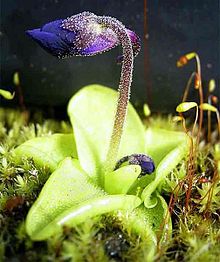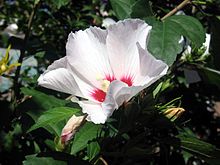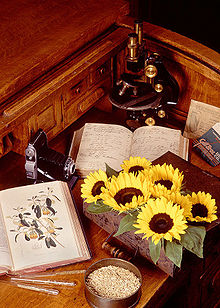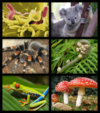- Botany
-
"Botanist" redirects here. A botanist is a person engaged in botany.
Botany, plant science(s), or plant biology is a branch of biology that involves the scientific study of plant life. Traditionally, botany also included the study of fungi, algae and viruses. Botany covers a wide range of scientific disciplines including structure, growth, reproduction, metabolism, development, diseases, chemical properties, and evolutionary relationships among taxonomic groups. Botany began with early human efforts to identify edible, medicinal and poisonous plants, making it one of the oldest branches of science. Today botanists study over 550,000 species of living organisms.
The term "botany" comes from Greek βοτάνη, meaning "pasture, grass, fodder", perhaps via the idea of a livestock keeper needing to know which plants are safe for livestock to eat.
Contents
Scope and importance of botany
As with other life forms in biology, plant life can be studied from different perspectives, from the molecular, genetic and biochemical level through organelles, cells, tissues, organs, individuals, plant populations, and communities of plants. At each of these levels a botanist might be concerned with the classification (taxonomy), structure (anatomy and morphology), or function (physiology) of plant life.
Historically all living things were grouped as animals or plants,[1] and botany covered all organisms not considered animals. Some organisms included in the field of botany are no longer considered to belong to the plant kingdom – these include bacteria (studied in bacteriology), fungi (mycology) including lichen-forming fungi (lichenology), non-chlorophyte algae (phycology) and viruses (virology). However, attention is still given to these groups by botanists, and fungi (including lichens), and photosynthetic protists are usually covered in introductory botany courses.
The study of plants is vital because they are a fundamental part of life on Earth, which generates the oxygen, food, fibres, fuel and medicine that allow humans and other life forms to exist. Through photosynthesis, plants absorb carbon dioxide, a greenhouse gas that in large amounts can affect global climate. Additionally, they prevent soil erosion and are influential in the water cycle. A good understanding of plants is crucial to the future of human societies as it allows us to:
- Produce food to feed an expanding population
- Understand fundamental life processes
- Produce medicine and materials to treat diseases and other ailments
- Understand environmental changes more clearly
Paleobotanists study ancient plants in the fossil record. It is believed that early in the Earth's history, the evolution of photosynthetic plants altered the global atmosphere of the earth, changing the ancient atmosphere by oxidation.
Human nutrition
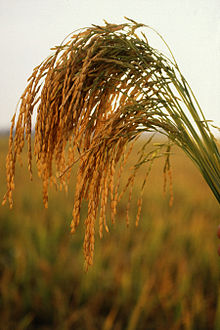 Nearly all the food we eat comes (directly and indirectly) from plants, such as this American long grain rice
Nearly all the food we eat comes (directly and indirectly) from plants, such as this American long grain rice
Virtually all foods eaten come from plants, either directly from staple foods and other fruit and vegetables, or indirectly through livestock or other animals, which rely on plants for their nutrition. Plants are the fundamental base of nearly all food chains because they use the energy from the sun and nutrients from the soil and atmosphere, converting them into a form that can be consumed and utilized by animals; this is what ecologists call the first trophic level. Botanists also study how plants produce food we can eat and how to increase yields and therefore their work is important in mankind's ability to feed the world and provide food security for future generations, for example, through plant breeding. Botanists also study weeds, plants which are considered to be a nuisance in a particular location. Weeds are a considerable problem in agriculture, and botany provides some of the basic science used to understand how to minimize 'weed' impact in agriculture and native ecosystems. Ethnobotany is the study of the relationships between plants and people, and when this kind of study is turned to the investigation of plant-people relationships in past times, it is referred to as archaeobotany or paleoethnobotany.
Fundamental life processes
Plants are convenient organisms in which fundamental life processes (like cell division and protein synthesis) can be studied, without the ethical dilemmas of studying animals or humans. The genetic laws of inheritance were discovered in this way by Gregor Mendel, who was studying the way pea shape and other traits are inherited. What Mendel learned from studying plants has had far reaching benefits outside of botany. Additionally, Barbara McClintock discovered 'jumping genes' by studying maize. These are a few examples that demonstrate how botanical research has an ongoing relevance to the understanding of fundamental biological processes.
Medicine and materials
Many medicinal and recreational drugs, like tetrahydrocannabinol, caffeine, and nicotine come directly from the plant kingdom. Others are simple derivatives of botanical natural products; for example, aspirin is based on the pain killer salicylic acid which originally came from the bark of willow trees. As well, the narcotic analgesics such as morphine are derived from the opium poppy.[2] There may be many novel cures for diseases provided by plants, waiting to be discovered. Popular stimulants like coffee, chocolate, tobacco, and tea also come from plants. Most alcoholic beverages come from fermenting plants such as barley (beer), rice (sake) and grapes (wine).
Plants also provide us with many natural materials, such as hemp, cotton, wood, paper, linen, vegetable oils, some types of rope, and rubber. The production of silk would not be possible without the cultivation of the mulberry plant. Sugarcane, rapeseed, soy and other plants with a highly fermentable sugar or oil content have recently been put to use as sources of biofuels, which are important alternatives to fossil fuels (see biodiesel).
Environmental changes
Plants can also help us understand changes in on our environment in many ways.
- Understanding habitat destruction and species extinction is dependent on an accurate and complete catalog of plant systematics and taxonomy.
- Plant responses to ultraviolet radiation can help us monitor problems like ozone depletion.
- Analyzing pollen deposited by plants thousands or millions of years ago can help scientists to reconstruct past climates and predict future ones, an essential part of climate change research.
- Recording and analyzing the timing of plant life cycles are important parts of phenology used in climate-change research.
In many different ways, plants can act a little like the 'miners' canary', an early warning system alerting us to important changes in our environment. In addition to these practical and scientific reasons, plants are extremely valuable as recreation for millions of people who enjoy gardening, horticultural and culinary uses of plants every day.
History
Main article: History of botanyEarly botany
The History of botany begins with ancient writings on, and classifications of, plants. Such writings are found in several early cultures. Examples of early botanical works have been found in Ancient Indian sacred texts, ancient Zoroastrian writings,[citation needed] and Ancient Chinese works.
The Greco-Roman world produced a number of botanical works including the Historia Plantarum and De Materia Medica.
Works from the medieval Muslim world included Ibn Wahshiyya's Nabatean Agriculture, Abū Ḥanīfa Dīnawarī's (828-896) the Book of Plants, and Ibn Bassal's The Classification of Soils.[citation needed] In the early 13th century, Abu al-Abbas al-Nabati, and Ibn al-Baitar (d. 1248) also wrote on botany.
Early modern botany
German physician Leonhart Fuchs (1501–1566) was one of the three founding fathers of botany, along with Otto Brunfels (1489–1534) and Hieronymus Bock (1498–1554) (also called Hieronymus Tragus).[3]
Valerius Cordus (1515–1554) authored a pharmacopoeia of lasting importance, the Dispensatorium in 1546.[4] As early as the 16th century, the Italian Ulisse Aldrovandi was scientifically researching plants. In 1665, using an early microscope, Robert Hooke discovered cells in cork, and a short time later in living plant tissue. The Germans Jacob Theodor Klein and Leonhart Fuchs, the Swiss Conrad von Gesner, and the British author Nicholas Culpeper published herbals covering the medicinal uses of plants.
During the 18th century, systems of classification became deliberately artificial and served only for the purpose of identification. These classifications are comparable to diagnostic keys, where taxa are artificially grouped in pairs by few, easily recognisable characters. The sequence of the taxa in keys is often totally unrelated to their natural or phyletic groupings. In the 18th century an increasing number of new plants had arrived in Europe, from newly discovered countries and the European colonies worldwide, and a larger amount of plants became available for study.
In 1754 Carl von Linné (Carl Linnaeus) divided the plant Kingdom into 25 classes. One, the Cryptogamia, included all plants with concealed reproductive parts (mosses, liverworts and ferns), and algae and fungi.[5]
The increased knowledge on anatomy, morphology and life cycles, lead to the realization that there were more natural affinities between plants, than the sexual system of Linnaeus indicated. Adanson (1763), de Jussieu (1789), and Candolle (1819) all proposed various alternative natural systems that were widely followed. The ideas of natural selection as a mechanism for evolution required adaptations to the Candollean system, which started the studies on evolutionary relationships and phylogenetic classifications of plants.
Botany was greatly stimulated by the appearance of the first “modern” text book, Matthias Schleiden's Grundzuge der Wissenschaftlichen, published in English in 1849 as Principles of Scientific Botany.[6] Carl Willdenow examined the connection between seed dispersal and distribution, the nature of plant associations and the impact of geological history. The cell nucleus was discovered by Robert Brown in 1831.
Modern botany
A considerable amount of new knowledge today is being generated from studying model plants like Arabidopsis thaliana. This weedy species in the mustard family was one of the first plants to have its genome sequenced. The sequencing of the rice (Oryza sativa) genome, its relatively small genome, and a large international research community have made rice an important cereal/grass/monocot model.[7] Another grass species, Brachypodium distachyon is also emerging as an experimental model for understanding the genetic, cellular and molecular biology of temperate grasses. Other commercially important staple foods like wheat, maize, barley, rye, pearl millet and soybean are also having their genomes sequenced. Some of these are challenging to sequence because they have more than two haploid (n) sets of chromosomes, a condition known as polyploidy, common in the plant kingdom. Chlamydomonas reinhardtii (a single-celled, green alga) is another plant model organism that has been extensively studied and provided important insights into cell biology.
In 1998 the Angiosperm Phylogeny Group published a phylogeny of flowering plants based on an analysis of DNA sequences from most families of flowering plants. As a result of this work, major questions such as which families represent the earliest branches in the genealogy of angiosperms are now understood. Investigating how plant species are related to each other allows botanists to better understand the process of evolution in plants.
Subdisciplines of botany
- Agronomy — Application of plant science to crop production
- Bryology — Mosses, liverworts, and hornworts
- Cryptobotany — Study of plants largely considered nonexistent
- Economic botany — Study of plants of economic use or value
- Ethnobotany — Relationship between humans and plants
- Forestry — Forest management and related studies
- Horticulture — Cultivated plants
- Lichenology — Lichens
- Mycology — Fungi
- Paleobotany — Fossil plants
- Palynology — Pollen and spores
- Phycology — Algae
- Phytochemistry — Plant secondary chemistry and chemical processes
- Phytopathology — Plant diseases
- Plant anatomy — Cell and tissue structure
- Plant ecology — Role of plants in the environment
- Plant genetics — Genetic inheritance in plants
- Plant morphology — Structure and life cycles
- Plant physiology — Life functions of plants
- Plant systematics — Classification and naming of plants
Notable botanists
- Isabella Abbott (1919–2010), world's leading expert on Hawaiian seaweeds; discovered over 200 species.
- Ibn al-Baitar (d. 1248), Andalusian-Arab scientist, botanist, pharmacist, physician, and author of one of the largest botanical encyclopedias.
- L.J.F. Brimble (1904–1965), English botanist and editor of Nature magazine
- Abu al-Abbas al-Nabati (c. 1200), Andalusian-Arab botanist and agricultural scientist, and a pioneer in experimental botany.
- Aimé Bonpland (1773–1858), French explorer and botanist, who accompanied Alexander von Humboldt during five years of travel in Latin America.
- Luther Burbank (1849–1926), American botanist, horticulturist, and a pioneer in agricultural science.
- Augustin Pyramus de Candolle (1778–1841), He originated the idea of "Nature's war", which influenced Charles Darwin.
- Abū Ḥanīfa Dīnawarī (828-896), Persian botanist, historian, geographer, astronomer, mathematician, and founder of Arabic botany.
- David Douglas (1799–1834), Scottish botanical explorer of North America and China, who imported many ornamental plants into Europe.
- Joseph Dalton Hooker (1817–1911), English botanist and explorer. Second winner of Darwin Medal.
- Pedanius Dioscorides (ca. 40-90 AD), physician, pharmacologist, toxicologist and botanist, author of Περὶ ὕλης ἰατρικής (Latin: De Materia Medica, English: "Regarding Medical Matters")
- Thomas Henry Huxley (1825–1895), English biologist, known as "Darwin's Bulldog" for his advocacy of Charles Darwin's theory of evolution. Third winner of Darwin Medal.
- Carl Linnaeus (1707–1778), Swedish botanist, physician and zoologist who laid the foundations for the modern scheme of Binomial nomenclature. He is known as the father of modern taxonomy, and is also considered one of the fathers of modern ecology.
- Gregor Johann Mendel (1822–1884), Augustinian priest and scientist, and is often called the father of genetics for his study of the inheritance of traits in pea plants.
- Charles Sprague Sargent (1841–1927), American botanist, the first director of the Arnold Arboretum at Harvard University.
- Carlos Muñoz Pizarro (1913–1976), Chilean botanist, known for his studies of the Chilean flora, and its conservation.
- Richard Spruce (1817–1893), English botanist and explorer who carried out a detailed study of the Amazon flora.
- Agustín Stahl (1842–1917), conducted investigations and experiments in the fields of ethnology, and zoology in the Caribbean region.
- George Ledyard Stebbins, Jr. (1906–2000), widely regarded as one of the leading evolutionary biologists of the 20th century, developed a comprehensive synthesis of plant evolution incorporating genetics.
- Theophrastus (c. 371 – c. 287 BC), father of botany, established botanical science through his lecture notes, Enquiry into Plants.
- Leonardo da Vinci (1452–1519), Italian polymath; a scientist, mathematician, engineer, inventor, anatomist, painter, sculptor, architect, botanist, musician and writer.
See also
- Bibliography of biology
- Botanical garden and List of botanical gardens
- Dendrochronology
- Edible Flowers
- Flowers and List of flowers
- Herbs
- Herbchronology
- History of plant systematics
- History of phycology
- List of botanical journals
- List of botanists
- List of Russian botanists
- List of botanists by author abbreviation
- List of domesticated plants
- List of systems of plant taxonomy
- Plant community
- Plant sexuality
- Seeds
- Soil science
- Trees
- Vegetation
- Weed Science
- Zoology
References
Notes
- ^ Chapman, Jasmin, et al.. Science Web. Nelson Thornes. pp. 56. ISBN 0-17-438746-6.
- ^ Mann, J. (1987). Secondary Metabolism, 2nd ed.. Oxford: Oxford University Press. pp. 186–187. ISBN 0-19-855529-6.
- ^ Early herbals – The German fathers of botany
- ^ Valerius Cordus | Science and Its Times: 1450-1699 Summary
- ^ Hoek, C. van den, Mann, D.G. and Jahns, H.M. 2005. Algae: An Introduction to Phycology. Cambridge University Press, Cambridge. ISBN 0 521 30419 9
- ^ Morton 1981, p. 377
- ^ Devos, Katrien M.; Gale, MD (2000). "Genome Relationships: The Grass Model in Current Research" (free full text). The Plant Cell 12 (5): 637–646. doi:10.2307/3870991. JSTOR 3870991. PMC 139917. PMID 10810140. http://www.plantcell.org/cgi/content/full/12/5/637.
Bibliography
Popular science
- Attenborough, David, The Private Life of Plants, ISBN 0-563-37023-8
- Bellamy, David, Bellamy on Botany, ISBN 0-563-10666-2 - An accessible and short introduction to various botanical subjects
- Capon, B., Botany for Gardeners, ISBN 0-88192-655-8
- Cohen, J., How many people can the earth support?, London: W. W. Norton, 1995, ISBN 0-393-31495-2
- Halle, Francis, In Praise of Plants, ISBN 0-88192-550-0 - English translation of a poetic advocacy of plants
- King, J., Reaching for the sun: How plants work, ISBN 0-521-58738-7 - A fluent introduction to how plants work
- Pakenham, Thomas (2002), Remarkable Trees of the World, ISBN 0-297-84300-1
- Pakenham, Thomas (1996), Meetings with Remarkable Trees, ISBN 0-297-83255-7
- Pollan, M., The Botany of Desire: a plant's-eye view of the world, London: Bloomsbury, ISBN 0-7475-6300-4 - Account of the co-evolution of plants and humans
- Thomas, B. A. (1981), The evolution of plants and flowers, New York: St Martin's Press, ISBN 0-312-27271-5
- Walker, D., Energy, Plants and Man, ISBN 1-870232-05-4 - A presentation of the basic concepts of photosynthesis
Academic and scientific
- Crawford, R. M. M. (1989). Studies in Plant Survival. Oxford: Blackwell ISBN 0-632-01475-X
- Matthews, R. E. F. Fundamentals of plant virology Academic Press,1992.
- Mauseth, J. D.: Botany : an introduction to plant biology. Jones and Bartlett Publishers, ISBN 0-7637-2134-4, A first year undergraduate level textbook
- Morton, A. G. (1981). History of Botanical Science.Academic Press, London. ISBN 0-12-508380-7 (hardback) ISBN 0-12-508382-3 (paperback)
- Raven, Peter H., Evert, Ray H. and Eichhorn, Susan E. (2005) Biology of Plants; 7th ed. New York: W. H. Freeman ISBN 1-57259-041-6 (A first year undergraduate level textbook; 1st ed. by Peter H. Raven; Helena Curtis. [New York]: Worth, 1970; 6th ed. 1999)
- Ridge, I. (2002) Plants Oxford University Press ISBN 0-19-925548-2
- Strange, R. L. (2003) Introduction to plant pathology. Weinheim: Wiley-VCH ISBN 0-470-84973-8
- Walter, H. (1985) Vegetation of the earth; 3rd rev. ed. Springer.
- Willis, K. (2002) The Evolution of Plants. Oxford University Press ISBN 0-19-850065-3 £22-99
- Environmental botany
- Crawley, M. J. (1997). Plant ecology. Blackwell Scientific ISBN 0-632-03639-7
- Ennos, Roland and Sheffield, Elizabeth Plant Life. Oxford: Blackwell Science ISBN 0-86542-737-2 Introduction to plant biodiversity
- Everitt, J. H.; Lonard, R. L., Little, C. R. (2007). Weeds in South Texas and Northern Mexico. Lubbock: Texas Tech University Press. ISBN 0896726142. ISBN 0-89672-614-2
- Richards, P. W. (1996). The Tropical Rainforest. 2nd ed. Cambridge U. P. (Pbk) ISBN 0-521-42194-2 £32.50
- Stace, C. A. (1997) A New Flora of the British Isles. 2nd ed. Cambridge U. P. ISBN 0-521-58935-5
- Plant physiology
- Bowsher, C. G., Steer, M. W. & Tobin, A. K. (2008) Plant Biochemistry. New York & Abingdon: Garland Science, Taylor & Francis Group ISBN 0-8153-4121-0
- Buchanan, B. B., Gruissem, W. & Jones, R. L. (2000) Biochemistry & Molecular Biology of Plants. American Society of Plant Physiologists ISBN 0-943088-39-9
- Fitter, A. & Hay, R. Environmental Physiology of Plants; 3rd edition. New York: Harcourt Publishers, Academic Press ISBN 0-12-257766-3
- Lambers, Hans, Chapin, F. Stuart, III and Pons, Thijs L. (1998) Plant Physiological Ecology. New York: Springer-Verlag ISBN 0-387-98326-0
- http://dx.doi.org/10.1007/978-0-387-78341-3 2nd completely revised edition. New York: Springer, 2008
- Lawlor, D. W. (2000) Photosynthesis BIOS ISBN 1-85996-157-6
- Salisbury, F. B. and Ross, C. W. (1992) Plant Physiology; 4th ed. Belmont, Calif: Wadsworth ISBN 0-534-15162-0
- Taiz, Lincoln & Zeiger, Eduardo (1991) Plant Physiology. Redwood City, Calif.: Benjamin/Cummings
- 3rd ed. Sunderland, Mass: Sinauer Associates, 2002 ISBN 0-87893-823-0
- 4th ed. Sunderland, Mass: Sinauer Associates, 2006 ISBN 978-0-87893-856-8
External links
- Botany at the Open Directory Project
- Botany databases at the Hunt Institute for Botanical Documentation
- The Virtual Library of Botany
- High quality pictures of plants and information about them from Catholic University of Leuven
- USDA plant database
- Native Plant Information Network
- Directory of Plants (PDF)
Botany Subdisciplines of botany Ethnobotany · Paleobotany · Plant anatomy · Plant ecology · Plant evo-devo · Plant morphology · Plant physiology
Plants Plant parts Plant cells Plant reproduction Plant taxonomy Glossaries History of botany Fields and disciplines Agriculture · Bryology · Cell theory · Cladistics · Comparative anatomy · Cytology · Economic botany · Ethnobotany · Floristics · Forestry · Genetic engineering · Horticulture · Lichenology · Molecular phylogenetics · Mycology · Natural history · Numerical taxonomy · Paleobotany · Palynology · Phycology · Phylogenetic nomenclature · Phytochemistry · Phytogeography · Plant anatomy · Plant ecology · Plant genetics · Plant morphology · Plant pathology · Plant physiology · Pteridology · Taxonomy · Ultrastructure
Institutions Publications Historia Plantarum of Theophrastus and Causes of Plants c. 200 BC · Materia Medica c. 60 AD · Naturalis Historia 77-79 AD · Herbarum Vivae Icones 1530 · Libellus De Re Herbaria Novus 1538 · Kreutterbuch 1539 · Historia Plantarum of John Ray 1561-1563 · De Plantis 1583 · Stirpium Historiae 1583 · Prodromus Theatrici Botanici 1620 · Pinax 1623 · Anatome Plantarum 1675 · Anatomy of Plants 1682 · Historia Plantarum 1682–1704 · De Sexu Plantarum Epistola 1694 · Vegetable Staticks 1727 · Systema Naturae 1735 · Genera Plantarum 1737 · Philosophia Botanica 1751 · Species Plantarum 1753 · Familles des Plantes 1763-4 · Experiments Upon Vegetables 1779 · Die Metamorphose der Pflantzen 1790 · Traité d'Anatomie et de Physiologie Végétale 1802 · Recherches Chimiques sur la Végétation 1804 · Beyträge zur Anatomie der Pflanzen 1812 · Prodromus Systematis Naturalis Regni Vegetabilis 1824-1841 · Die Vegetabilische Zelle 1851 · Vergleichende Untersuchungen 1851 · On the Origin of Species 1859 · Experiments on Plant Hybridization 1862 · Die Vegetation der Erde 1872 · Prodromus Systematis Naturalis Regni Vegetabilis 1873 · Plantesamfund 1895 · Pflanzengeographie auf Physiologischer Grundlage 1898 · Variation and Evolution in Plants 1950 · Ontogeny and Phylogeny 1977 · An Integrated System of Classification of Flowering Plants 1981Theories and concepts Alternation of generations · Biogeographical realm · Biological classification · Cell theory · Center of diversity · Spontaneous generationInfluential figures Theophrastus c. 371 – c. 287 BC · Pliny the Elder 23–79 AD · Pedanius Dioscorides c. 40-90 AD · Otto Brunfels 1464-1534 · Hieronymus Bock 1498-1554 · Valerius Cordus 1515-1544 · William Turner 1515-1568 · Rembert Dodoens 1517-1585 · Andrea Cesalpino 1519-1603 · Gaspard Bauhin 1560–1624 · Joachim Jungius 1587–1657 · John Ray 1623–1705 · Nehemiah Grew 1628–1711 · Marcello Malpighi 1628–1694 · Joseph Pitton de Tournefort 1656–1708 · Rudolf Jakob Camerarius 1665–1721 · Stephen Hales 1677–1761 · Bernard de Jussieu 1699–1777 · Carolus Linnaeus 1707–1778 · Michel Adanson 1727–1806 · Jan Ingenhousz 1730–1799 · Joseph Banks 1743–1820 · Johann Wolfgang von Goethe 1749–1832 · Carl Ludwig Willdenow 1765–1812 · Nicolas-Théodore de Saussure 1767–1845 · Alexander von Humboldt 1769–1859 · Aimé Bonpland 1773–1858 · Joakim Frederik Schouw 1789–1852 · Matthias Jakob Schleiden 1804–1881 · Alexander Braun 1805–1877 · Asa Gray 1810–1888 · August Grisebach 1814–1879 · Joseph Hooker 1817–1911 · Gregor Mendel 1822–1884 · Nathanael Pringsheim 1823–1894 · Wilhelm Hofmeister 1824–1877 · Julius von Sachs 1832–1897 · Eugenius Warming 1841–1924 · William Gilson Farlow 1844–1919 · Andreas Franz Wilhelm Schimper 1856–1901 · Nikolai Vavilov 1887–1943 · G. Ledyard Stebbins 1906–2000 · Eugene Odum 1913–2002 · Arthur Cronquist 1919–1992Related topics History of agricultural science · History of agriculture · History of biochemistry · History of biotechnology · History of ecology · History of evolutionary thought · History of genetics · History of geology · History of medicine · History of molecular biology · History of molecular evolution · History of paleontology · History of phycology · History of plant systematics · History of science · Natural philosophy · Philosophy of biology · Timeline of biology and organic chemistry · Herbal · Botanical gardenHorticulture and gardening Gardens 
Horticulture Organic Plant protection Categories:
Wikimedia Foundation. 2010.

